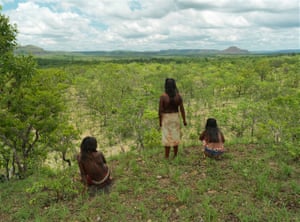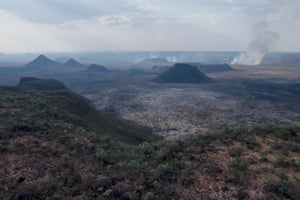It took just a few decades for Brazilian agriculture to transform its tropical savannah hinterlands – the Cerrado – into an agricultural powerhouse.
Farmers and the growing agribusiness sector celebrated rising sales of soya and beef, and the roads and towns that grew up with them. But environmentalists and Cerrado communities say the advances came at the price of roaring deforestation, land grabbing, violence and the loss of traditional lands.
Nearly half (44%) of the Cerrado’s native vegetation, which includes scrubland, grasslands and forests, is already used for agriculture, the MapBiomas monitoring project calculates. And under Brazil’s far-right president, Jair Bolsonaro, who is supported by powerful farming lobbies, the rest of its 2m sq km is disappearing fast. Last year alone, 6,500 sq km was cleared – adding to the 283,000 sq km of forest, grassland and scrub cut down since 2001.

This year so far the Cerrado has seen more than 61,000 fire alerts – up from 39,000 in the whole of 2018, before Bolsonaro took power – raising fears for its future. It is an immense, important carbon sink, storing hundreds of tons a hectare in its soil and deep root systems.
Q&A What is Brazil’s Cerrado and why is it in crisis?
Show
Hide
Brazil’s Cerrado biome is a vast, tropical savannah stretching diagonally up through the middle of Brazil that covers 2 million sq km, around 22% of the country, as well as parts of Bolivia and Paraguay.
According to Brazil’s environment ministry, the biodiversity-rich Cerrado has 11,620 plant, 1,200 fish and 837 fish species and its 200 mammals include jaguars, anteaters, rhea birds and tapirs. But over half of its landscape – grassland scrub and dry forest – has been converted to agriculture as it produces soya for China, Europe and other markets. The region lost 105,000 square kilometres of native cover from 2008-2018, according to Reuters – 50% more than the Amazon, which has more legal protection.
According to an international study published by Science magazine, around 27,000 properties in the Cerrado had carried out deforestation “in all likelihood illegally”, and 48% of properties were non-compliant with the requirements of Brazil’s forest code, such as protecting 20% of their land (compared to 80% in the Amazon). The study found around 20% of soya exports and 17% of beef exports from Brazil’s Amazon and Cerrado biomes to the European Union “may be contaminated with illegal deforestation”.
Another study by researchers from Dartmouth College in the US, published in Nature Sustainability magazine, found land clearing had changed the weather in the Cerrado. Temperatures were hotter during the corn growing season and evapotranspiration fell.
Last year, in an article published in Perspectives in Ecology and Conservation, scientists warned that “climate changes are likely to cause local extinctions of several mammalian species throughout the Cerrado biome”.
Dom Phillips in Rio de Janeiro
“The Cerrado is like the water tank of Brazil. This is impacting the fluvial regime of rivers, of important rivers,” said Britaldo Soares-Filho, professor of environmental modelling at the Federal University of Minas Gerais. “The Cerrado is a biodiversity hotspot and is under a lot of pressure.”
A diagonal swathe across the middle of Brazil, the Cerrado covers around 22% of the country. Its rich wildlife includes 11,620 plant species and more than 200 species of mammals, including jaguars, anteaters, rhea birds and tapirs.
Ignored for years, the region took on more importance after the country’s capital was moved to Brasilia in the middle of the Cerrado in 1960 and states in the centre-west began filling with farms. Brazil’s military dictatorship from 1964-1985 launched programmes to modernise Cerrado agriculture, improve its infrastructure and colonise its remoter areas.
In the late 1970s, a Japanese-Brazilian programme was launched to help colonise and develop the region to guarantee soya supplies. Big multinational traders such as Cargill and Bunge moved in. Chinese investment helped pave roads and improve ports. “They created a structure that favoured export,” said Roberto Miranda, a professor of sociology at the Federal University of Campina Grande.
The Amazon – which is even larger than the Cerrado – was also being increasingly exploited. But that destruction was attracting international attention and concern: meanwhile the Cerrado stayed below the radar. In a 2017 paper, Soares-Filho and other researchers calculated that while 49% of the Amazon was in protected areas such as conservation units and indigenous reserves, just 7.7% of the Cerrado was. Under Brazil’s 2012 Forest Code, farmers are required to leave 80% of Amazon land as a “legal reserve”, but just 20% in most of the Cerrado region. “The Cerrado was the poor relation,” said Soares-Filho. As a result, agribusiness loved it.
The region’s “agricultural frontier” is a huge area Matopiba, home to former president Dilma Rousseff’s Matopiba development agency. “In the agriculture area, we are still capable of picking low-hanging fruit – and at the same time, expanding the tree,” Rousseff said at the launch in 2015. “That’s why it’s a very special moment.”

Farmers who moved into the region were realistic. “Our ambition was never to get rich, but we wanted to have something in life,” said Paulo Dalto Neto, who came to farm here in 1997. Land was cheap in this dry, inhospitable region, but he has been able to improve his soil, develop the local roads and plant hardy soya strains with high yields.
The losers were the Cerrado’s traditional communities, who usually did not have legal titles to land they had used for generations. Soya farmers prized this land and in some cases unscrupulous land dealers were able to buy or simply steal it by falsifying documents. “The soya here brought us very few jobs … and brought us many disadvantages,” said Juarez de Souza, 63, from the tiny Melancias community in Piaui.
De Souza’s community is now engaged in a legal battle to prove ownership of their land, while the river local people used for water and fishing has, according to De Souza, been polluted by pesticides. He says he has received threats from land grabbers looking for land to sell on to bigger farmers. “For them the soya is gold,” he said. “There is a lot of money.”

Moreover, the change in land use is now altering the climate of the region. There is less rain and the temperatures are higher, he says: studies show deforestation contributes to droughts and erratic river behaviour. And meanwhile the farmers chop away, bit by bit, at its natural vegetation.
The problem is that, while Brazil struggles with an economic downturn as a result of the coronavirus pandemic, which has so far resulted in 169,000 deaths, the Cerrado’s production of soya, sold mostly for animal feed, is booming – and expected to reach a record 135m tons for the 2020-2021 harvest. “This is the strength of our agribusiness,” Tereza Cristina Dias, Brazil’s agriculture minister, tweeted on 10 November. Brazil expects record beef exports in November – with the lion’s share of the country’s cattle raised in Cerrado states.
With Brazil running a heavy deficit, worsened by its emergency pandemic payments to tens of millions of people and a record 14% unemployment, its booming exports of agricultural commodities such as soya and beef come as a relief, said Fabio Klein, a public accounts analyst at Tendencias, a Sao Paulo consulting outfit. “Agriculture is a very competitive sector, and the income it generates, although concentrated, spills over the rest of the economy, which is good for the country and the government.”

Brazilian soya’s high protein and oil count makes it especially popular in China, Brazil’s biggest soya customer, says Kory Melby, an American agribusiness consultant based in the Cerrado town of Goiania. “International and domestic markets are telling Brazil that even though Brazil is expanding as fast as she can, we would like her to expand even faster,” he says. “That blows my mind.”
The problem is that while the Cerrado may seem like low-hanging fruit, in the long term Brazil is losing yet more of its precious forests and wildlife. Their loss will come with a heavy cost.
Sign up for the Animals farmed monthly update to get a roundup of the best farming and food stories across the world and keep up with our investigations. You can send us your stories and thoughts at animalsfarmed@theguardian.com